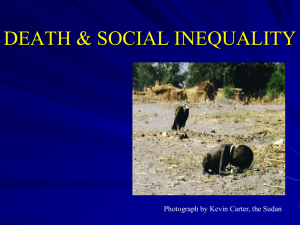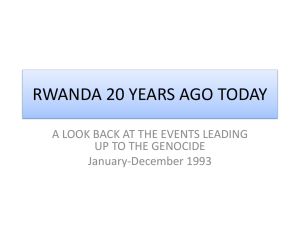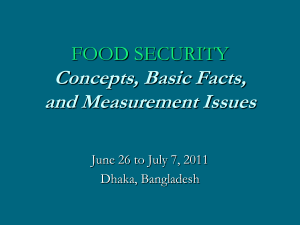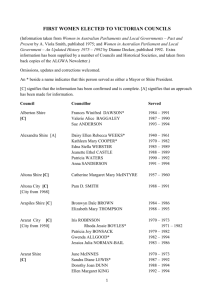Income Distribution and Living Difficulties During the
advertisement
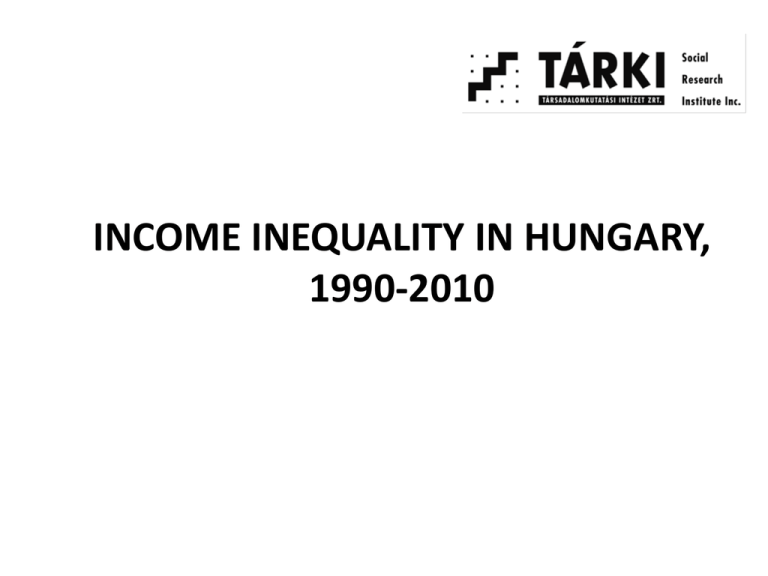
INCOME INEQUALITY IN HUNGARY, 1990-2010 Long run evolution of inequality of per capita household income Source: Tóth, 2002, 2009. Data are from: 1962-1987: Hungarian Central Statistical Office Income Survey; 1992, 1995, 1996: Hungarian Household Panel; 1999–2009: Tárki Household Monitor. Steep increase in income inequalities 1987-1996 (1) Increasing inequality of labour income Shrinking share of labour income: • Employment decline (emp. rate from 76% (1990) to 58% (1996)) • Increase in capital income: entrepreneurial income, privatisation Austerity package 1995: freezing wages in public sector, meanstested family allowance, rising retirement age, tuition in higher education, Steep increase in income inequalities 1987-1996 (1) Inequality of gross monthly earnings of full-time employees (men and women) •rising returns to education •rising regional wage differences But •lowering gender wage gap •less steep age profile Note: Data are gross monthly earnings of full-time employees in May of each year. Data source: Enterprise survey (Survey of Individual Wages and Earnings). Before 1994, workers in private enterprises of less than 20 employees were not included. Since 1994, the sample also covers enterprises with 10-20 employees. Data exclude enterprises with 5-9 employees. Data include 1/12 of non-regular payments from previous year Source: OECD Earnings Database Moderate decline in income inequality 2003-2007 (1) Share of per capita personal income deciles from total HH disposable incomes between 1962 and 2009 25,0 20,0 S1 S5+S6 S10 15,0 10,0 5,0 0,0 1962 1967 1972 1977 1982 1987 1992 1996 2000 2003 2005 Source: 1962–1987: KSH income surveys, Atkinson–Micklewright [1992] Table HI1.; 1992–1996: HHP waves I–VI., 2000–2009: Tárki Household Monitor. 2007 2009 Moderate decline in income inequality 2003-2007 (2) Social and economic policies influencing income distribution Between 2002–2006: •50% increase of public sector wages •Introduction of 13th month pension •Redirecting family support to lower income groups (abolishing family tax allowances, raising family allowances) •VAT reduction After the summer of 2006: • Increasing health care insurance contribution • Increase of the upper rate of individual income tax • Increase of the rate of EVA (”standardized entrepreneur tax”) They drive to the same direction: first the lower-middle class get better, then the status of the upper-middle class get worse. The crisis years, changes between 2007-2009 (1) Change in average incomes of various income deciles (person equivalent* income) between 2007 and 2009 Inflation (14%) Average income growth (7%) No change level * e=0.73 The crisis years, changes between 2007-2009 (2) Share of per capita personal income deciles from total HH disposable incomes between 1962 and 2009 25,0 20,0 S1 S5+S6 S10 15,0 10,0 5,0 0,0 1962 1967 1972 1977 1982 1987 1992 1996 2000 2003 2005 Source: 1962–1987: KSH income surveys, Atkinson–Micklewright [1992] Table HI1.; 1992–1996: HHP waves I–VI., 2000–2009: Tárki Household Monitor. 2007 2009 The crisis years, changes between 2007-2009 (3) Ratio of lower cutpoint of top decile and upper cutpoint of lowest decile (P90/P10) Ratio of top/bottom decile shares (S10/S1) 8,0 7,5 7,0 6,5 6,0 5,5 5,0 4,5 4,0 3,8 3,6 3,4 3,2 3,0 2,8 2,6 1987 1992 1996 2000 2003 2005 2007 2009 1987 Gini coefficient 15,0 0,32 1992 1996 2000 2003 2005 2007 2009 Relative poverty rate (OECD2: median 60%) 14,0 0,30 13,0 0,28 12,0 0,26 11,0 0,24 10,0 0,22 9,0 1987 1992 1996 2000 2003 2005 2007 2009 8,0 1987 1992 1996 2000 2003 2005 2007 2009 Forrás: 1987: KSH jövedelemfelvétel; 1992–1996: Magyar Háztartás Panel I–VI. hullámai, 2000–2009: Tárki Háztartás Monitor. Megj: 95% konf. int. mellett, személyi ekvivalens jövedelmek személyi eloszlása alapján. Szeg. Ráta 1987: e=0 ,73 alapján The crisis years, changes between 2007-2009 (4) No. of Persons living in households with different emplyoment composition adults (estimate, 000 persons) Hh head empl, no other empl. Hh head empl, + other empl. Hh head inactive head pensioner, no employed head pensioner, + employed The crisis years, changes between 2007-2009 (5) Proportion of households repaying bank loans by income quintile Source: Tárki Household Monitor The crisis years, changes between 2007-2009 (6) Percentage of households who have been in arrears of repaying debt during year 2009 50% 45% 40% 35% 30% 25% 20% 15% 10% 5% 0% Lowest quintile 2nd quintile Mortgages 3rd quintile All bank loans Source: Tárki Household Monitor 4th quintile Richest quintile Total sample Foreign currency denominated loans The crisis years, changes between 2007-2009 (7) Percentage of households experiencing living difficulties 18 16 14 14 15 14 12 12 10 10 8 8 6 5 5 2001 2003 4 4 4 2005 2007 2 0 Can't make ends meet Source: Tárki Household Monitor 2009 Troubles paying for rent and utilities At-risk-of-poverty rate by age, 1992-2009 (%) Source: TÁRKI. A summary of poverty analysis socio-demographic profile •Significant increase: between 1992-1996 and 2007-2009 •Consistent high risk group village 3+ children inactive hh head max. primary educ. head Roma consistent low risk group Budapest 0 child second earner in the hh at least secondary educ. not roma •high risk, increased: households with at least 1 child and for the primary educated •low risk, decreased: head 60+, pensioner headed hh





